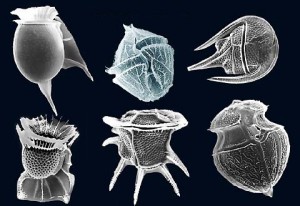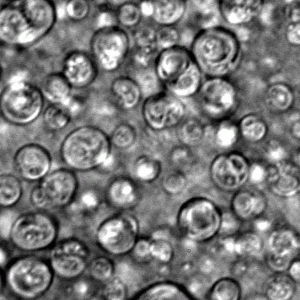
Saxitoxin produced by dinoflagellates (above), algae and shellfish could help stop neuropathic pain before it starts. (fickleandfreckled/Flickr)
A cut, a bruise, a scrape…these can all cause pain that, while unpleasant, usually passes quickly. But for an estimated 3.75 million children and adults in the United States with neuropathic pain, the pain is debilitating and never goes away.
Caused by diabetes, shingles, nerve trauma, cancer and other conditions, neuropathic pain is basically a sign that someone’s nervous system has lost track of what should and shouldn’t cause pain.
There are ways to treat or control neuropathic pain, like lifestyle changes and a range of medications, but they don’t target it at its source. Boston Children’s Hospital’s Daniel Kohane, MD, PhD, wants to do just that: to go for the root of neuropathic pain, maybe even stop it before it starts. And he’s doing it with microscopic beads full of a neurotoxin found in shellfish.
While the molecular picture isn’t completely clear, neuropathic pain usually starts with an injury or condition that damages a nerve. The damaged nerve does what nerves do: it signals the spinal cord and brain (which together form the central nervous system, or CNS) that something’s wrong, causing the sensation of pain.
According to the leading theory, something then goes awry, and the damaged nerve doesn’t stop signaling. Over time, the constant noise from the nerve lowers the CNS’s pain threshold. As a result, the slightest touch near the original injury site—sometimes even no touch at all—can cause anything from constant tingling and numbness to shooting, burning pain.
Kohane, along with collaborator Robert Langer, ScD, at the Massachusetts Institute of Technology, wanted to find a way to stop that cascade of events and move beyond the options available now to patients.
“There has been significant interest in using powerful local anesthetics to block aberrant nerve discharges from the site of injury to prevent the onset of neuropathic pain,” says Kohane, who works in Boston Children’s Department of Anesthesia. “Others have tried with varying degrees of success to do this in animal models using a variety of methods. But if applied clinically, those methods would require surgical intervention or could be toxic to tissues. We want to avoid both of those concerns.
Their solution: fat-based microspheres called liposomes filled with saxitoxin, a powerful local anesthetic derived from paralytic shellfish toxin (think red tide). The liposomes—which are only about five and a half micrometers wide, or a bit smaller than a red blood cell—also contain dexamethasone, a steroid that helps the saxitoxin’s effects last longer.
Kohane and Langer first tried out their saxitoxin dexamethasone liposomes (or SDLs for short) in 2009, showing they could, in an animal model, reduce short-term pain without causing additional damage. In this week’s Proceedings of the National Academy of Sciences, the pair (along with postdoctoral fellow Sahadev Shankarappa, MBBS, MPH, PhD, and others) reported the next step: using SDLs to block local nerve signaling at the site of nerve injury and delay neuropathic pain’s appearance.
In their model, one dose of SDLs right after injury had only a mild effect, delaying the onset of neuropathic pain by a couple days compared to untreated animals. However, three doses spread out over 12 days delayed the pain by a month, suggesting that the SDLs could indeed keep the injured nerve quiet.
The SDLs’ effects extended to the animals’ dorsal horn—a part of the spine that relays pain signals from the body to the CNS. When the team examined the dorsal horn five or 60 days after injury, they found no sign that it was registering pain from the injury site; the SDLs had completely blocked the signals.
Kohane has already begun the next steps.
“We’re trying to refine our methods so that we can get individual injections to last longer and figure out how to generalize the method to other models of neuropathic pain,” he says. “We also need to see whether it is safe to block nerve activity in this way for this long. We don’t want to inadvertently trade one problem for another. But we think that this approach could be fruitful for preventing and treating what is really a horrible condition.”








